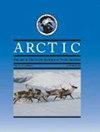Participatory Video: One Contemporary Way for Cree and Inuit Adolescents to Relate to the Land in Nunavik
IF 0.8
4区 地球科学
Q4 ENVIRONMENTAL SCIENCES
引用次数: 0
Abstract
Indigenous peoples in Canada’s North, especially youth, are increasingly using creative visual arts, such as film, video, and new media technologies to portray their own realities and their personal view of the surrounding environment, thereby contesting colonial, stereotyped media representations of First Peoples. To analyze the youth geography—a sub-discipline of human geography—of nuna (“land” in Inuktitut) and istchee (“land” in Cree) and to understand the distinctive and contemporary meanings that Inuit and Cree young people give to the land, we carried out participatory video (PV) workshops in three Inuit and one Cree communities in Nunavik in 2016, 2017, and 2019. In this paper, we give an account of the nuna/istchee PV project as a method for engaging with young Indigenous people, as a means to develop an Indigenous youth cultural geography in the Arctic. We discuss the effects of PV on the different actors involved in the research process: young Inuit and Cree participants and their communities, the participating schools, and researchers.参与式视频:克里族和因纽特人青少年与努纳维克土地关系的一种当代方式
加拿大北部的原住民,尤其是年轻人,越来越多地使用创造性的视觉艺术,如电影、视频和新媒体技术来描绘他们自己的现实和他们对周围环境的个人看法,从而与殖民主义、刻板印象的媒体对第一民族的描述相抗衡。为了分析nuna(因纽特语中的“土地”)和istchee(克里语中的“土地”)的青年地理学(人文地理学的一个分支学科),并了解因纽特人和克里族年轻人赋予土地的独特和当代意义,我们于2016年、2017年和2019年在努纳维克的三个因纽特人和一个克里人社区开展了参与式视频(PV)研讨会。在本文中,我们将nuna/istchee PV项目作为一种与土著青年接触的方法,作为在北极发展土著青年文化地理的一种手段。我们讨论了PV对参与研究过程的不同参与者的影响:年轻的因纽特人和克里人参与者及其社区、参与的学校和研究人员。
本文章由计算机程序翻译,如有差异,请以英文原文为准。
求助全文
约1分钟内获得全文
求助全文
来源期刊

Arctic
地学-环境科学
CiteScore
2.30
自引率
0.00%
发文量
51
审稿时长
6-12 weeks
期刊介绍:
Arctic is a peer-reviewed, primary research journal that publishes the results of scientific research
from all areas of Arctic scholarship. Original scholarly papers in the physical, social, and biological
sciences, humanities, engineering, and technology are included, as are book reviews,
commentaries, letters to the editor, and profiles of significant people, places, or events of northern
interest
 求助内容:
求助内容: 应助结果提醒方式:
应助结果提醒方式:


